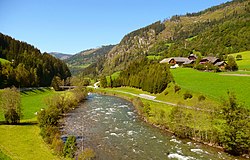This article needs additional citations for verification. (September 2010) |
| Mur/Mura | |
|---|---|
 The Mur Valley near Tamsweg in Austria | |
 | |
| Location | |
| Countries | |
| Physical characteristics | |
| Source | |
| • location | Hohe Tauern at Muhr, Austria |
| • coordinates | 47°7′48″N 13°20′49″E / 47.13000°N 13.34694°E |
| • elevation | 1,898 m (6,227 ft) |
| Mouth | |
• location | Drava near Legrad, Croatia |
• coordinates | 46°18′19″N 16°52′39″E / 46.30528°N 16.87750°E |
• elevation | 130 m (430 ft) |
| Length | 463.7 km (288.1 mi) [1] |
| Basin size | 14,109 km2 (5,448 sq mi) |
| Discharge | |
| • average | 166 m3/s (5,900 cu ft/s) |
| Basin features | |
| Progression | Drava→ Danube→ Black Sea |





The Mur (German pronunciation: [ˈmuːɐ̯] ) or Mura (Slovene: [ˈmúːɾa]; Croatian: [mǔːra]; Hungarian: [ˈmurɒ]; Prekmurje Slovene: Müra[2] or Möra[2]) is a river in Central Europe rising in the Hohe Tauern national park of the Central Eastern Alps in Austria with its source at 1,898 m (6,227 ft) above sea level. It is a tributary of the Drava and subsequently the Danube.
The Mur's total length is around 464 kilometres (288 mi).[1] About 326 km are within the interior of Austria; 95 km flow in and around Slovenia (67 km along the borders with Austria and Croatia, 28 km inside Slovenia),[3] and the rest forms the border between Croatia and Hungary. The largest city on the river is Graz, Austria. Its drainage basin covers an area of 14,109 km2 (5,448 sq mi).[4]
Tributaries of the Mur include the Mürz, the Sulm, the Ščavnica, the Ledava and the Trnava.
- ^ a b Digitaler Atlas der Steiermark (Styria)
- ^ a b Novak, Vilko. 2006. Slovar stare knjižne prekmurščine. Ljubljana: ZRC SAZU, pp. 262, 269.
- ^ Rivers, longer than 25 km, and their catchment areas, Statistical Office of the Republic of Slovenia
- ^ "Flächenverzeichnis der Flussgebiete: Murgebiet" (PDF). Beiträge zur Hydrografie Österreichs Heft 60. October 2011. p. 126.